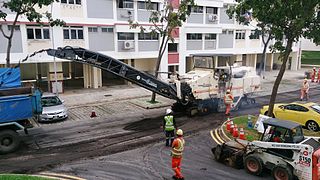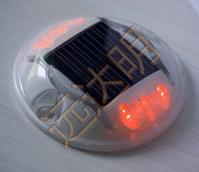 W
WAsphalt concrete is a composite material commonly used to surface roads, parking lots, airports, and the core of embankment dams. Asphalt mixtures have been used in pavement construction since the beginning of the twentieth century. It consists of mineral aggregate bound together with asphalt, laid in layers, and compacted. The process was refined and enhanced by Belgian inventor and U.S. immigrant Edward De Smedt.
 W
WChaussee is an historic term used in German-speaking countries for early, metalled, rural highways, designed by road engineers, as opposed to the hitherto, traditional, unpaved country roads. The term is no longer used in modern road construction in Western Europe, but survives in road names and is used by historians. In Eastern Europe and the post Soviet states it remains a generic term for a common paved highway outside of built-up areas, but they may transition into prospekts within towns and cities.
 W
WConstruction barrels are traffic control devices used to channel motor vehicle traffic through construction sites or to warn motorists of construction activity near the roadway. They are used primarily in the United States, but are occasionally used in Canada and Mexico. They are an alternative to traffic cones which are smaller and easily hit by vehicles. Drums tend to command more respect from drivers than cones as they are larger, more visible, and give the appearance of being formidable obstacles.
 W
WDecomposed granite is classification of rock that is derived from granite via its weathering to the point that the parent material readily fractures into smaller pieces of weaker rock. Further weathering yields material that easily crumbles into mixtures of gravel-sized particles known as grus, that further may break down to produce a mixture of clay and silica sand or silt particles. Different specific granite types have differing propensities to weather, and so differing likelihoods of producing decomposed granite. It has practical uses that include its incorporation into paving and driveway materials, residential gardening materials in arid environments, as well as various types of walkways and heavy-use paths in parks. Different colors of decomposed granite are available, deriving from the natural range of granite colors from different quarry sources, and admixture of other natural and synthetic materials can extend the range of decomposed granite properties.
 W
WA grader, also commonly referred to as a road grader, motor grader, or simply a blade, is a form of heavy equipment with a long blade used to create a flat surface during grading. Although the earliest models were towed behind horses, and later tractors, most modern graders are self-propelled and thus technically "motor graders".
 W
WThe King road drag was a road grader implement for grading dirt roads that revolutionized the maintenance of the dirt roads in the early 1900s. It was invented by David Ward King, who went by "D. Ward King" and who was a farmer whose farm was in Holt Township, near Maitland, Missouri.
 W
WNicolson pavement, alternatively spelled "Nicholson" and denominated wooden block pavement and wood block pavement, is a road surface material consisting of wooden blocks. Samuel Nicolson invented it in the mid-19th century. Wooden block pavement has since become unfavored because of its poor surface quality and high cost of maintenance.
 W
WPavement milling is the process of removing at least part of the surface of a paved area such as a road, bridge, or parking lot. Milling removes anywhere from just enough thickness to level and smooth the surface to a full depth removal. There are a number of different reasons for milling a paved area instead of simply repaving over the existing surface.
 W
WA paver is a piece of construction equipment used to lay asphalt on roads, bridges, parking lots and other such places. It lays the asphalt flat and provides minor compaction before it is compacted by a roller.
 W
WA pothole is a depression in a road surface, usually asphalt pavement, where traffic has removed broken pieces of the pavement. It is usually the result of water in the underlying soil structure and traffic passing over the affected area. Water first weakens the underlying soil; traffic then fatigues and breaks the poorly supported asphalt surface in the affected area. Continued traffic action ejects both asphalt and the underlying soil material to create a hole in the pavement.
 W
WRiver gravel is a name given to gravel composed of small pieces of rounded stone of various colors, usually no larger than a large coin. It is named for the effect of many years of rounding of the edges of the stones due to a flow of water over it, as often takes place in a river. River gravel is often used in outdoor settings, such as a park walkway.
 W
WA road roller is a compactor-type engineering vehicle used to compact soil, gravel, concrete, or asphalt in the construction of roads and foundations. Similar rollers are used also at landfills or in agriculture.
 W
WA rut is a depression or groove worn into a road or path by the travel of wheels or skis. Ruts can be formed by wear, as from studded snow tires common in cold climate areas, or they can form through the deformation of the asphalt concrete, pavement or subbase material. In modern roads the main cause is heavily loaded trucks. These heavy loaded trucks imprint their tire impressions on roads over time, causing ruts. Rut is a common pavement distress and is often used in pavement performance modeling.
 W
WA smart work zone or intelligent work zone refers to a site-specific configuration of traffic control technology deployed within a roadway work zone to increase the safety of construction workers, provide "real-time" travel information, and efficiently route motorists through a work zone. Smart work zones reduce the dependency on human "flaggers" and make the work zone safer for roadway workers.
 W
WSolar road studs are flashing solar cell powered LED maintenance-free lighting devices used in road construction to delineate road edges and centrelines. Embedded in the road surface, they are an electronic improvement on the traditional cat's eyes in that they may give drivers more than a thirty-second reaction window compared with about 3 seconds for conventional reflective devices. The intense brightness of the LEDs makes them easily visible at distances of about 900 m under favourable conditions.
 W
WSosrobahu is a road construction technique which allows long stretches of flyovers to be constructed above existing major roads with minimum disruption to traffic. The technique was designed and invented by Indonesian engineer Tjokorda Raka Sukawati and involves the construction of the horizontal supports for the highway beside the existing road, which are then lifted and turned 90 degrees angle before being placed on the top of the vertical supports to form the flyover pylons.
 W
WA steamroller is a form of road roller – a type of heavy construction machinery used for leveling surfaces, such as roads or airfields – that is powered by a steam engine. The levelling/flattening action is achieved through a combination of the size and weight of the vehicle and the rolls: the smooth wheels and the large cylinder or drum fitted in place of treaded road wheels.
 W
WTramlining is the tendency of a vehicle's wheels to follow the contours in the surface upon which it runs. The term comes from the tendency of a car's wheels to follow the normally recessed rails of street trams, without driver input in the same way that the train does. The same effect is sometimes called Nibbling.